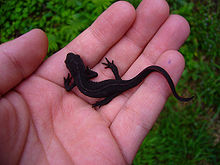- Japanese Fire Belly Newt
-
fire bellied newts 
Conservation status Scientific classification Kingdom: Animalia Phylum: Chordata Class: Amphibia Order: Caudata Family: Salamandridae Genus: Cynops Species: C. pyrrhogaster Binomial name Cynops pyrrhogaster
(Boie, 1826)The Japanese Fire Belly Newt (Cynops pyrrhogaster) is a common Asian newt. It is commonly confused with the Chinese Fire Belly Newt (Cynops orientalis) due to similarities in coloring and size, and most newts sold as Japanese Fire Bellys are likely to be the more commonly collected Chinese Fire Belly instead.
Description
This newt is usually 3.5 - 5.5 inches [1] long and can be distinguished from its Chinese relative by its larger size, rough, pebbly skin and distinct parotoid glands. They are typically brown to black above, often with red specks or spots, and orange to crimson below, usually with a blotched darker pattern.[1] Males can be distinguished from females by their swollen cloacas, and male newts of this species will often become a blue iridescent sheen and smoother skin during the breeding season.
In the wild this species of newt lives on the islands of Honshū, Shikoku, and Kyūshū. It lives in clear, cool bodies of water, usually ponds, ditches, pools, or lakes.[1] There are reportedly six subspecies or races found through the Japanese islands. These six races are Atsumi, Hiroshima, Kanto, Sasayama, and Touhoku.[1] Each race originating from the region of Japan they are named after.
These newts are poisonous in the wild, however animals bred in captivity "may" lose their toxicity. The skin of the wild animals contains Tetrodotoxin (TTX), which is one of the most effective non-peptide toxins known to man. It is a neurotoxin, which has no known antidote and can cause death by suffocation in as little as six hours after ingestion.[2] It is speculated that the toxin could be formed by environmental bacteria, and this could be the reason that some newts in captivity have a lower toxicity than their wild counterparts.[2]
In captivity
Japanese Fire Belly newts prefer aquarium with a small land area to crawl out on and heavy stands of aquatic plants. They do not need any special lighting, but incandescent light can be used. You will need at least a 2.5 gallon terrarium. The best land-water ratio is 1/3 land and 2/3 water, with at least 4 inches in depth. It is best to have a hiding spot/cave to avoid stressing out the newts. The ideal substrates for a newt terrarium are either any moss besides peat moss, sand, or fairly large gravel to avoid ingestion. The water should be about 60-74°F, though these newts can tolerate much higher temperatures than other species.
Like other newts, they can be fed commercial pellets or freeze-dried food, but if they refuse these, they should be given live food such as bloodworms, earthworms, mosquito larva, ghost shrimp[disambiguation needed
 ], nightcrawlers, or pinhead crickets. In order to feed a newt earthworms of any sort, you must chop them into bite sized pieces. Worms can live as long as 8 years if kept at good health. At least one inch of the clitellum (head) is left. You can either feed by hand, or with tweezers of forceps of some kind. Uneaten crickets must be removed, as they will bite a sleeping newt.
], nightcrawlers, or pinhead crickets. In order to feed a newt earthworms of any sort, you must chop them into bite sized pieces. Worms can live as long as 8 years if kept at good health. At least one inch of the clitellum (head) is left. You can either feed by hand, or with tweezers of forceps of some kind. Uneaten crickets must be removed, as they will bite a sleeping newt.It isn't a good idea to house them with other amphibians other than their own kind because the fire-bellied toad is known to try to eat newts. They may be housed with their close relative, Cynops orientalis but it is not recommended as Cynops pyrrhogaster tends to get larger by at least two inches.
References
- Kaneko & Matsui (2004). Cynops pyrrhogaster. 2006. IUCN Red List of Threatened Species. IUCN 2006. www.iucnredlist.org. Retrieved on 12 May 2006. Database entry includes a range map and justification for why this species is of least concern
Categories:- IUCN Red List least concern species
- Newts
- Model organisms
- Amphibians of Japan
Wikimedia Foundation. 2010.


